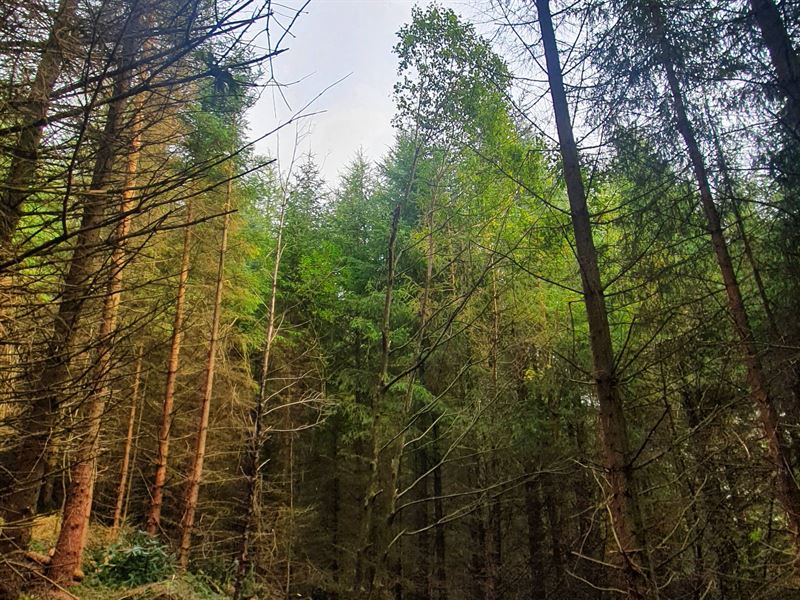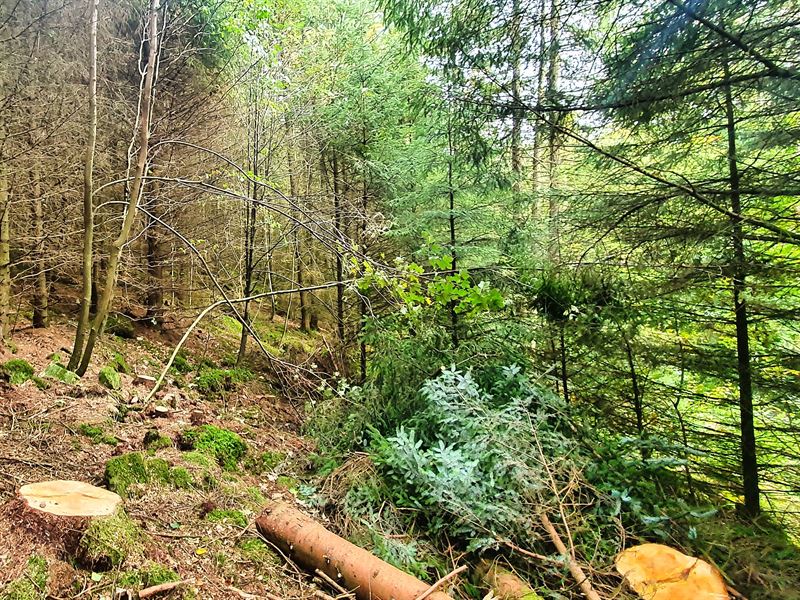Thinning at Swirls-
In September we saw the start of work thinning out the existing canopy at Swirls. This worked alongside Tree Skills, who were running a chainsaw course, allowing those learning to be part of the restoration work and create training opportunities within the project.
The thinning targeted those trees that were not appropriate to ancient woodland and identified key remnant features such as broadleaf trees which had been overshadowed. The Sitka Spruce and associated low levels of light that they can produce are detrimental to the regeneration of native species and surviving remnant ancient woodland trees.
With improved light levels, these remnant trees can grow more easily, more quickly and provide a seed source for natural regeneration in the area.
Encouraging appropriate light levels also benefits the ground vegetation which, once established is better for precipitation interception, delay of runoff, and overall water quality. This delivers direct benefits to Thirlmere in improving the water quality of the reservoir and mitigating flooding in surrounding areas.
Beech Thinning at Dale Head & Great How
Although beech is a native tree to England, it is not native to the immediate area around Thirlmere. It casts heavy shade and produces a lot of leaf litter. This, in combination with the chemicals present in the leaf litter of beech, creates unsuitable conditions for certain vegetation and trees.
The natural Oak habitat in Dale Head and the South Eastern corner of Great How is suffering as a result of large, domineering beech trees, so these are being selectively thinned over a very long period of time to improve the light levels. To avoid damage to nearby remnant oaks, the trees are being climbed and dismantled by a team of arborists from William Atherton Arboricultural Services.
This will allow the oaks that are present to dominate the canopy creating a dappled light that will allow native vegetation to flourish and an understory of native tree species to establish. The beech that is felled will be left as deadwood on the forest floor, providing a diverse woodland habitat for a range of mosses, lichens, insects and birds.


Red Squirrel Monitoring throughout the Valley
Thirlmere Valley is a red squirrel reserve and the areas in which red squirrels are most active are the ancient woodland sites. As restoration work is going on in or near these areas, we wanted to make sure there was no impact to the red squirrels or their habitats so Matthew Stuart, the red squirrel ranger from Red Squirrels North East, was contacted.
Additional monitoring was then funded as part of the Thirlmere restoration project to survey red squirrel populations before, during and after intervention works to make sure impact was minimal. As well as this, extra time was allocated for control of grey squirrels further reducing the pressure on reds in the valley.
As a final mitigation measure, we have ordered a number of trees as part of the planting plan that are a preferred food source by red squirrels and will plant them in select areas to ensure, in future, there will be a continual food source at all times of the year.
Western Hemlock Clearing in Swirls
When assessing threats in the valley it was found that some non-native conifers are more problematic than others when it comes to PAWS restoration. Western hemlock is at the top of the list in this situation as it regenerates aggressively and prefers to do so in low light conditions. Due to the valley's topography and localised climate, the whole area is suitable for western hemlock to regenerate and especially so in Swirls where it has carpeted the area.
We worked with Arbclear who removed all of the western hemlock regeneration from a 15ha area, neatly stacking the waste and pegging it into rows which not only provides a clear site for ease of future operations, but also creates a habitat replicating that of a hedgerow allowing cover for birds and squirrels. This is very important in this area as there is very little tree cover remaining due to it being a previous clearfell site.